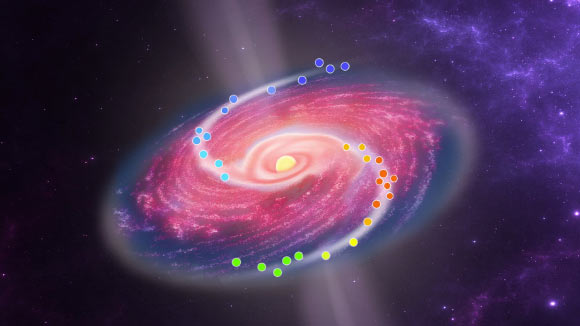New observations of a high-mass protostar in the massive star-forming region G358.93-0.03 shed light on how these young stellar objects accumulate their mass.

An artist’s impression of the immediate vicinity of the massive protostar G358.93-0.03-MM1. Image credit: Xi Chen, Guangzhou University / Zhi-Yuan Ren, National Astronomical Observatories, Chinese Academy of Science.
High-mass protostars are thought to accumulate much of their mass via short, infrequent bursts of accretion. Such accretion events are rare and difficult to observe directly.
In a previous study, University of Tasmania’s Professor Simon Ellingsen and colleagues focused on a high-mass young stellar object called G358.93-0.03-MM1.
This protostar is embedded within G358.93-0.03, a massive star-forming region located approximately 22,000 light-years away in the constellation of Ophiuchus.
The astronomers managed to identify and observe an accretion burst in real time from its onset, a rare opportunity that helped prove the episodic accretion theory of stellar formation.
In the new study, they created a high resolution map of the molecular gas swirling around G358.93-0.03-MM1.
“From our observations, we’re able to map gas close to the protostar in 3D, and it looks like the material flowing onto the star has formed a spiral structure,” Professor Ellingsen said.
The spiral pattern provides an explanation as to why the accretion happens in bursts, rather than more steadily.
“These protostars are in many ways the most important for the evolution of galaxies over cosmic time, but at the moment, we don’t have a good understanding of how they form,” Professor Ellingsen said.
“Observing the formation of these giants is hard — there aren’t very many of them, they form quickly, and the formation is hidden deep within very dense gas clouds which blocks light at most wavelengths.
“Our new observations are providing some of the most direct information as to how these stars accumulate their mass and are opening up an exciting new window to study these rare events.”
“G358.93-0.03-MM1 is the first example of a massive protostar whose sudden increase in brightness clearly coincides with the formation of a spiral, a structure that suggests an unstable, massive disk,” said Professor Xi Chen, a researcher in the Center for Astrophysics at GuangZhou University.
“In conjunction with theoretical models, it is thus possible for the first time to establish a direct correlation between the variation in luminosity and the accretion of individual packets of matter from an unstable, massive disk.”
“This result suggests that disk-mediated accretion could therefore be regarded as a common mechanism for star formation of low-mass to high-mass stars.”
The findings appear in the journal Nature Astronomy.
_____
X. Chen et al. New maser species tracing spiral-arm accretion flows in a high-mass young stellar object. Nat Astron, published online July 13, 2020; doi: 10.1038/s41550-020-1144-x







